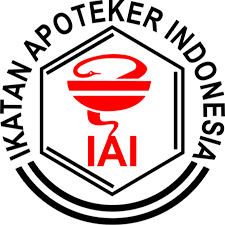Identifikasi Kandungan Hidrokuinon pada Krim Pemutih yang Beredar di Pasar Tradisional Wilayah Kabupaten Banjarnegara
Sabtanti Harimurti(1*), Ika Sevi Deriyanti(2), Hari Widada(3), Pinasti Utami(4)(1) Universitas Muhammadiyah Yogyakarta
(2) Program Studi Farmasi, Fakultas Kedokteran dan Ilmu Kesehatan, Universitas Muhammadiyah Yogyakarta
(3) Program Studi Farmasi, Fakultas Kedokteran dan Ilmu Kesehatan, Universitas Muhammadiyah Yogyakarta
(4) Program Studi Farmasi, Fakultas Kedokteran dan Ilmu Kesehatan, Universitas Muhammadiyah Yogyakarta
(*) Corresponding Author
Abstract
Keywords
Full Text:
PDFReferences
Adams, R.M, and Maibach, H.I. 1985. A five-year study of cosmetic reactions, Journal American Academic Dermatologic 13: 1062-1069.
Azhara, K.N. 2011. Waspada bahaya kosmetik, Flashbooks, Jogjakarta.
Badan Pengawas Obat dan Makanan. 2007. Kosmetik mengandung bahan berbahaya dan zat warna yang dilarang : keputusan kepala Badan Pengawas Obat dan Makanan Republik Indonesia No HK.00.01.432.6081.
Day, R.A., Underwood, A.L. 2002. Analisis kimia kuantitatif edisi keenam, Erlangga, Jakarta.
Elferjani, H.S, Ahmida, N.H.S, and Ahmida, A. 2017. Determination of hydroquinone in some pharmaceutical and cosmetic preparation by spectrophotometric method, International Journal of Science and Research (IJSR), 6(7): 2219-2224.
Ibrahim, S., Damayanti, S., Riani, Y. 2004. Penetapan dan keseksamaan metode kolorimetri menggunakan pereaksi floroglusin untuk penetapan kadar hidrokuinon dalam krim pemucat, Acta Pharmaceutica Indonesia, Vol 29.
James, J.A. 2006. Skin lightening and depigmenting agent, Journal of The European Academy of Dermatology and Veneurologi, Medical Centre Department Dermatology University Pennsylvania.
Karunawati, M.S. 2013. Validasi metode kromatografi lapis tipis densitometri pada penetapan kadar campuran deksametason dan deksklorfeniramin maleat dalam kaplet, Skripsi, Fakultas Farmasi Universitas Sanata Dharma, Yogyakarta.
Mayaserli, D.P., dan Sasmita, W. 2016. Pemeriksaan kadar merkuri dan keluhan kesehatan dalam darah wanita pemakai krim pemutih dengan metode inductively coupled plasma, Jurnal of Sainstek 8: 159-165.
Ningsih, A.U. 2009. Identifikasi hidrokuinon dalam krim pemutih, Skripsi, Fakultas Matematika dan Ilmu Pengetahuan Alam Universitas Sumatra Utara, Medan.
Nurfitriani, S., Hadisoebroto, G., Budiman S. 2015. Analisis penetapan kadar hidrokuinon pada kosmetik krim pemutih yang beredar di beberapa tempat di kota Bandung, Prosiding SNIFA UNJANI 2015.
Peraturan Kepala Badan Pengawas Obat dan Makanan. 2011. Persyaratan teknis bahan kosmetika, Jakarta (ID): Nomor HK.03.1.23.08.11.07517 Tahun 2011.
Peraturan Kepala Badan Pengawas Obat Dan Makanan. 2015. Persyaratan teknis bahan kosmetika, Jakarta (ID): Nomor 18 Tahun 2015.
Rasyid, R., Susanti, E., dan Azhar, R. 2015. Pemeriksaan kualitatif hidrokuinon dan merkuri dalam krim pemutih, Jurnal Farmasi Higea 7: 63-73.
Sarah, K.W. 2014. Analisis hidrokuinon dalam sediaan krim malam cw 1 dan cw 2 dari klinik kecantikan N dan E di kabupaten Sidoarjo, Jurnal Ilmiah Mahasiswa Universitas Surabaya 3: 1-27.
Siddique, S., Parveen, Z., Ali, Z., and Zaheer, M. 2012. Qualitative and quantitative estimation of hydroquinone in skin whitening cosmetics, Journal Of Cosmetics, Dermatological Sciences and Applications 2: 224-228.
Syafinir, L, dan Putri, A.P. 2011, Pengujian kandungan merkuri dalam sediaan kosmetik dengan spektrofotometri serapan atom, Prosiding SNAPP 2011: Sains, teknologi dan kesehatan 2: 71-78.
Tsai, T.C., and Hantash, B.M. 2008, Cosmeceutical agents: a comprehensive review of the literature, Clinical Medicine Insigths:Dermatology 1: 1.
Wulandari, L., Retnaningtyas, Y., Mustafidah, D. 2013. Pengembangan dan validasi metode kromatografi lapis tipis densitomeri untuk penetapan kadar teofilin dan efedrin hidroklorida secara simultan pada sediaan tablet, JKTI 15: 15-21.
Article Metrics
Abstract view(s): 1653 time(s)PDF: 3655 time(s)
Refbacks
- There are currently no refbacks.








